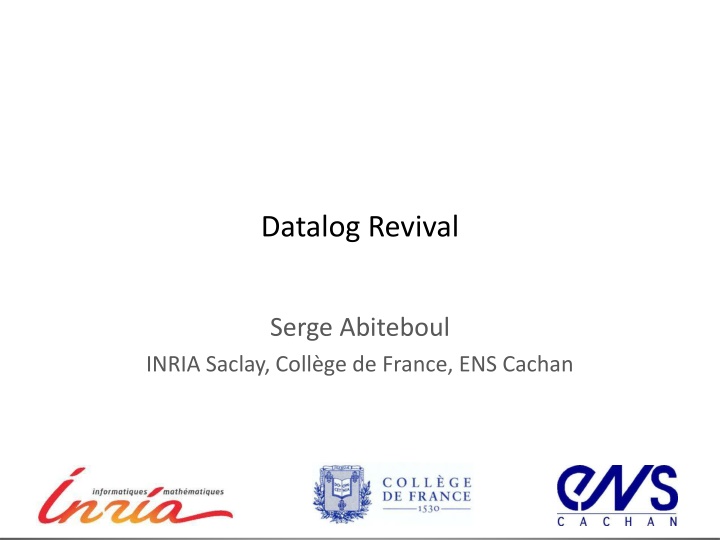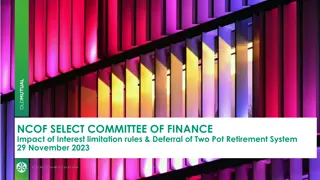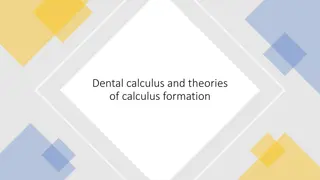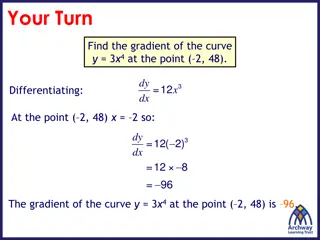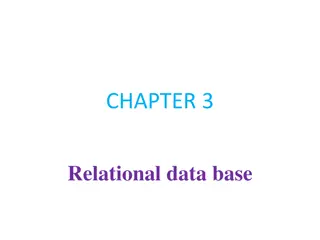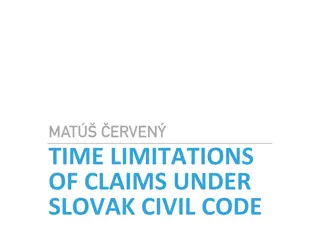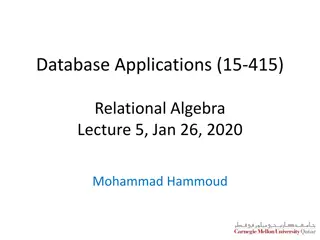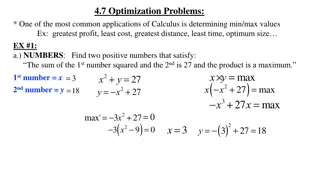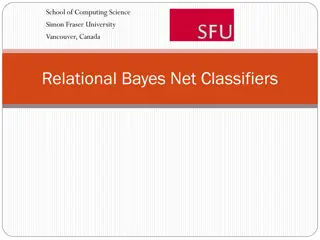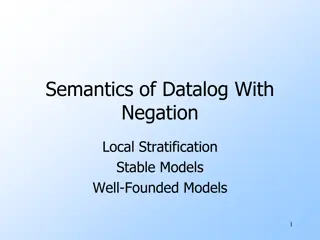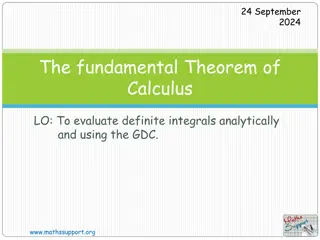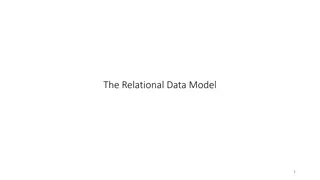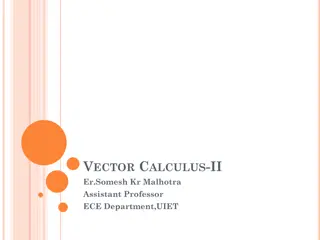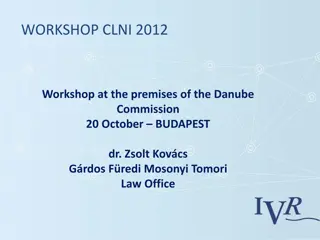Datalog Revival and Limitation of Relational Calculus
Datalog, a logic-based programming language, saw a revival in the 21st century with the addition of recursion to positive first-order queries. The history of Datalog traces back to the 1970s with the idea of adding recursion to FO queries. Despite the industry's initial lack of interest, Datalog found a resurgence in recent years. The limitations of relational calculus and the concepts of terms, constants, and variables are also explored in this informative content.
Download Presentation

Please find below an Image/Link to download the presentation.
The content on the website is provided AS IS for your information and personal use only. It may not be sold, licensed, or shared on other websites without obtaining consent from the author.If you encounter any issues during the download, it is possible that the publisher has removed the file from their server.
You are allowed to download the files provided on this website for personal or commercial use, subject to the condition that they are used lawfully. All files are the property of their respective owners.
The content on the website is provided AS IS for your information and personal use only. It may not be sold, licensed, or shared on other websites without obtaining consent from the author.
E N D
Presentation Transcript
Datalog Revival Serge Abiteboul INRIA Saclay, Coll ge de France, ENS Cachan 9/25/2024 9/25/2024 9/25/2024 1 1 1
FO+ Datalog history loop FO datalog Started in 77: logic and database workshop Simple idea: add recursion to positive FO queries Blooming in the 80th Logic programming was hot Industry was not interested: No practical applications of recursive query theory have been found to date. Hellerstein and Stonebraker (Readings in DB Systems) Quasi dead except local resistance [e.g., A.,Gottlob] datalog Revival in this century 9/25/2024 2
Organization Datalog Datalog evaluation Datalog with negation Datalog revival Conclusion 9/25/2024 3
Datalog 9/25/2024 4
Limitation of relational calculus G a graph: G(0,1), G(1,2), G(2,3), Is there a path from 0 to 11 in the graph? G(10,11) 0 1 4 5 8 9 2 3 6 7 10 11 k-path x1 xk( G(0,x1) G(x1,x2) G(xk-1,xk) G(xk,11) ) Path of unbounded length: infinite formula k=1 to k-path 9/25/2024 5
Term = constant or variable Datalog program = set of datalog rules Datalog G(2,3) T(x, y) G(x, z), T(z, y) fact rule datalog rule : R1(u1) R2(u2), . . . ,Rn(un) for n 1 head body Each uiis a vector of terms Safe: each variable occurring in head must occur in body Intentional relation: occurs in the head Extensional relation: does not 9/25/2024 6
Datalog program 1. 2. 3. 4. G(0,1), G(1,2), G(2,3), G(10,11) T(x, y) G(x, y) T(x, y) G(x, z), T(z, y) Ok() T(0, 11) edb(P) = {G} idb(P) = {T,Ok} program P 9/25/2024 7
Datalog program 1. 2. 3. 4. G(0,1), G(1,2), G(2,3), G(10,11) T(x, y) G(x, y) T(x, y) G(x, z), T(z, y) Ok() T(0, 11) T(10, 11) G(10, 11) T(9, 11) G(9,10), T(10, 11) T(0, 11) G(0,1), T(1, 11) Ok() T(0, 11) T(10,11) T(9,11) Rule 2: v(x)=10 & v(y) = 11 Rule 3: v(x)=9, v(z)=10 & v(y)=11 Rule 3: v(x)=0, v(z)=1 & v(y)=11 Rule 4: v(x)=0, v(y)=11 T(0,11) Ok() 9/25/2024 8
Model semantics View P as a first-order sentence P describing the answer Associate a formula to each rule R1(u1) R2(u2), . . . ,Rn(un) : x1, . . . , xm( R2(u2) . . . Rn(un) R1(u1) ) where x1, . . . , xmare the variables occurring in the rule P = {r1, ..., rn}, P= r1 ... rn The semantics of P for a database I, denoted P(I), is the minimum model of Pcontaining I Does it always exist? How can it be computed? 9/25/2024 9
Example: Transitive closure G(0,1), G(1,2), G(2,3) T(x,y) G(x,y) T(x,y) G(x,z), T(z,y) G ---- 0 1 0 1 1 2 1 2 2 3 2 3 P G ---- 0 1 0 1 1 2 1 2 2 3 2 3 P G ---- 0 1 0 1 1 2 1 2 2 3 2 3 P ---- G ---- 0 1 0 1 1 2 1 2 P ---- ---- ---- 0 2 1 3 0 3 6 3 0 2 0 2 1 3 0 2 1 3 0 3 Minimum model containing I Does not contain I Not a model of the formula Model but not minimal 9/25/2024 10
Existence of P(I) There exists at least one such model: the largest instance one can build with the constants occurring in I and P is a model of P that includes I B(I,P) P(I) always exists: it is the intersection of all models of P that include I over the constants occurring in I and P How can it be computed? 9/25/2024 11
Fixpoint semantics A fact A is an immediate consequence for K and P if 1. A is an extensional fact in K, or 2. for some instantiation A A1, . . . , Anof a rule in P, each Aiis in K Immediate consequence operator: TP(K) = { immediate consequences for K and P } Note: TP is monotone 9/25/2024 12
Fixpoint semantics continued P(I) is a fixpoint of TP That is: TP(P(I)) P(I) Indeed, P(I) is the least fixpoint of TP containing I Yields a means of computing P(I) I TP(I) TP2(I) ... Tpi(I) = Tpi+1(I)= P(I) B(I,P) 9/25/2024 13
Proof theory Proof technique: SLD resolution A fact A is in P(I) iff there exists a proof of A 9/25/2024 14
Static analysis Hard Deciding containment (P P ) is undecidable Deciding equivalence is undecidable Deciding boundedness is undecidable There exists k such that for any I, the fixpoint converges in less than k stages So, optimization is hard 9/25/2024 15
Datalog evaluation by example 9/25/2024 16
More complicated example: Reverse same generation up a a f g h i j flat g m m p down l m g h i p e f m n n o o f n o m f f b c d k rsg(x,y) flat(x,y) rsg(x,y) up(x,x1),rsg(y1,x1),down(y1,y) 9/25/2024 17
rsg(x,y) flat(x,y) rsg(x,y) up(x,x1),rsg(y1,x1),down(y1,y) f g f m n m o p m a b h f i j f f k a c a d f f l m n o p d u d u u u u d f f e f g h i j k rsg d u u d d a b c d rsg 9/25/2024 18
Naive algorithm Fixpoint rsg0= rsgi+1= flat rsgi 16( 2=4( 3=5(up rsgii down))) Program rsg := ; repeat rsg := flat rsg 16( 2=4( 3=5(up rsg down))) until fixpoint 9/25/2024 19
Semi-naive 1(x, y) flat(x, y) i+1(x, y) up(x, x1), i(y1, x1), down(y1, y) Compute I Program Converges to the answer Not recursive & not a datalog program Still redundant to avoid it: i+1(x, y) up(x, x1), i(y1, x1), down(y1, y), i(x, y) 9/25/2024 20
rsg(x,y) flat(x,y) rsg(x,y) up(x,x1),rsg(y1,x1),down(y1,y) f g f m n m o p m a b h f i j f f k a c a d f 1 f l m n o p d u d u u u u d f f e f g h i j k 2 d u u d d a b c d 3 9/25/2024 21
Semi-nave (end) More complicated if the rules are not linear T(x, y) G(x, y) T(x, y) T(x, z), T(z, y) 1(x, y) G(x, y) anc1:= 1 tempi+1(x, y) i(x, z), anci(z, y) tempi+1(x, y) anci(x, z), i(z, y) i+1 := tempi+1 anci anci+1 := anci i+1 9/25/2024 22
And beyond Start from a program and a query rsg(x,y) flat(x,y) rsg(x,y) up(x,x1),rsg(y1,x1),down(y1,y) query(y) rsg(a, y) Optimize to avoid deriving useless facts Two competing techniques that are roughly equivalent Query-Sub-Query Magic Sets 9/25/2024 23
Magic Set rsgbf(x, y) input_rsgbf(x), flat(x, y) rsgfb(x, y) input_rsgfb(y), flat(x, y) sup31(x, x1) input_rsgbf(x), up(x, x1) sup32(x, y1) sup31(x, x1), rsgfb(y1, x1) rsgbf(x, y) sup32(x, y1), down(y1, y) sup41(y, y1) input_rsgfb(y), down(y1, y) sup42(y, x1) sup41(y, y1), rsgbf(y1, x1) rsgfb(x, y) sup42(y, x1), up(x, x1) input_rsgbf(x1) sup31(x, x1) input_rsgfb(y1) sup41(y, y1) Seed input_rsgbf(a) Query query(y) rsgbf(a, y) 9/25/2024 24
QSQ at work Subqueries rsgfb(y1,e) rsgfb(y1,f) rsgbf(x,y) rsgbf(x,y) up(x,x1), rsgfb(y1,x1), down(y1,y) flat(x,y) sup0(x) sup1(x,y) sup0(x) sup1(x,x1) sup2(x,y1) sup3(x,y) a a e a f a g a b a rsgfb(x,y) rsgfb(x,y) flat(x,y) down(y1,y), rsgbf(y1,x1), up(x,x1) sup0(y) sup1(x,y) e f sup0(y) sup1(y,y1) sup2(y,x1) sup3(x,y) g f e f input-rsgbf input-rsgfb ans-rsgbf ans-rsgfb a e f a b g f 9/25/2024 25
Datalogby example Accept negative literal in body Complement of transitive closure CompG(x,y) G(x,y) 9/25/2024 27
More complicated Some TPhave a least fixpoint but sequence diverges P3= {p r ; r p; p p, r} alternates between and {p, r} But {p} is a least fixpoint Some TPare not monotone Some TPhave no fixpoint containing I P1= {p p} {p} {p} Model semantics Some programs have no model containing I Some program have several minimal models containing Some TPhave several minimal fixpoints containing I P2= {p q, q p} Two minimal fixpoints: {p} and {q}. 9/25/2024 28
First fix: stratification Impose condition on the syntax Stratified programs datalog datalog datalog datalog Consider more complex semantics Many such proposals Well-founded semantics based on 3-valued logic 9/25/2024 29
e, g are loosing Well-founded by example: 2-player game c b e move graph: (relation K) a d f g There is a pebble in a node 2 players alternate playing A player moves the pebble following an edge A player who cannot move loses 9/25/2024 30
d,f are winning Winning position c b e move graph: (relation K) a d f g There is a pebble in a node 2 players alternate playing A player moves the pebble following an edge A player who cannot move loses 9/25/2024 31
a, b, c unknown No winner no looser c 2 b 1 e move graph: (relation K) a 1 2 d f g There is a pebble in a node 2 players alternate playing A player moves the pebble following an edge A player who cannot move loses 9/25/2024 32
Program to specify the winning/loosing positions win(x) move(x, y), win(y) Well-founded semantics: find the instance J that agrees with K on move and satisfies the formula corresponding to the rule Instance J win(d),win(f ) win(e),win(g) win(a),win(b),win(c) three-valued instance are true are false are unknown Fixpoint semantics based on 3-valued logic 9/25/2024 33
Fixpoint computation win(x) move(x, y), win(y) e c b No maybe g a d f yes I0: win is always false I1: win: a, b, c, d, f I2: win: d, f I3: win: a, b, c, d, f I4: win: d, f 9/25/2024 34
Complexity and expressivity Datalog and Datalog evaluations are easy Datalog Ptime In the data Inclusion in ptime: polynomial number of stages; each stage in ptime Strict: Expresses only monotone queries; But does not even express all PTIME monotone queries Datalog with well-founded semantics = fixpoint Ptime In the data On ordered databases, it is exactly PTIME 9/25/2024 35
Datalog revival 9/25/2024 36
Datalog revival Datalog needs to be extended to be useful Updates, value creation, nondeterminism [e.g. A., Vianu] [e.g. Gottlob] [e.g. Revesz] [e.g. Chomicki] [e.g. ActiveXML] [e.g. ActiveXML] [e.g. Consens and Mendelzon] [e.g. Webdamlog] Skolem Constraints Time Distribution Trees Aggregations Delegation 9/25/2024 37
Datalog revival: different domains Declarative networking Data integration and exchange Program verification Data extraction from the Web Knowledge representation [e.g. Lou et al] [e.g. Clio, Orchestra] [e.g. Semmle] [e.g. Gottlob, Lixto] [e.g. Gottlob] Artifact and workflows Web data management [e.g. ActiveXML] [e.g. Webdamlog] 9/25/2024 38
Declarative networking Traditional vs. declarative Network state Network protocol Messages Series of languages/systems from Hellerstein groups in Berkeley Overlog, bloom, dedalus, bud Performance: scalability Many systems have been developed Internet routing Overlay networks Sensor networks Distributed database Datalog program Messages 9/25/2024 39
Data integration Eid, Name, Addr ( employee(Eid, Name, Addr) Ssn ( name(Ssn, Name) address(Ssn, Addr) ) ) Use inverse rules with Skolem name(ssn(Name, Addr), Name) address(ssn(Name, Addr), Addr) employee(X, Name, Addr) employee(X, Name, Addr) Possibly infinite chase and issues with termination 9/25/2024 40
Program analysis Analyze the possible runs of a program Recursion Lots of possible runs lots of data Optimization techniques are essential Semi-na ve, Magic Sets, Typed-based optimization 9/25/2024 41
Data extraction Georg s talk next 9/25/2024 42
Conclusion 9/25/2024 43
Issues Give precise semantics to the extensions Some challenges for the Web Scaling to large volumes Datalog with distribution Datalog with uncertainty Datalog with inconsistencies Berkeley s works Webdamlog 9/25/2024 44
Merci ! 9/25/2024 9/25/2024 9/25/2024 45 45 45
Georg Gottlob, Professor at Oxford University & TU Wien Research: database, AI, logic and complexity Fellow of St John's and Ste Anne s College, Oxford Fellow: ACM, ECCAI, Royal Society Academy: Austrian, German, Europaea Program chair: IJCAI, PODS Founder of Lixto, a company on web data extraction ERC Advanced Investigator's Grant (DIADEM) 9/25/2024 46
